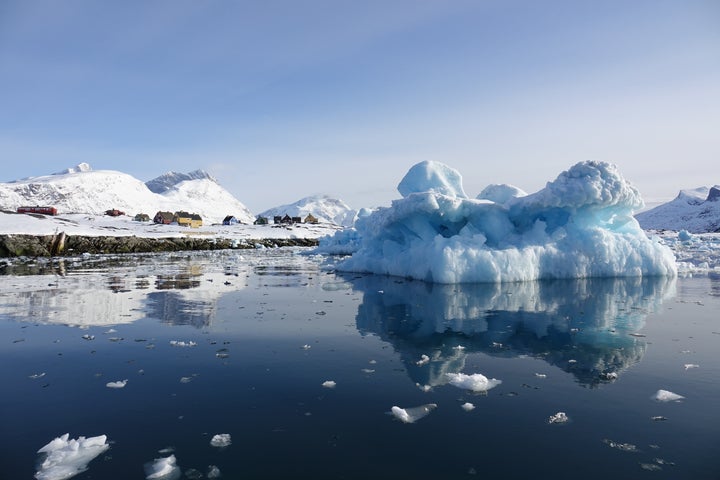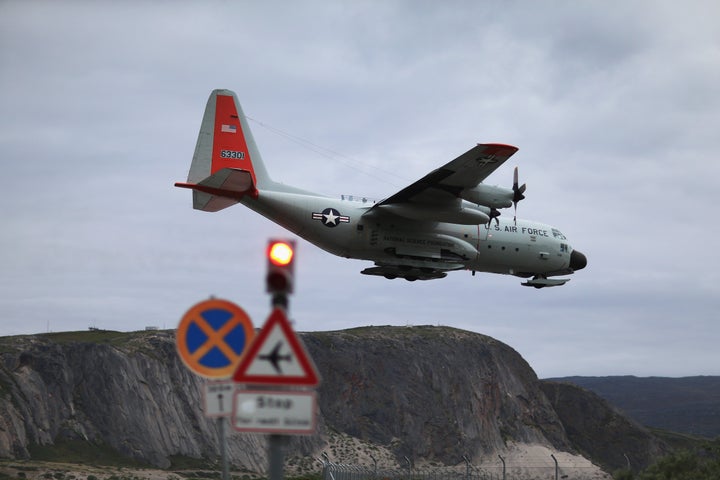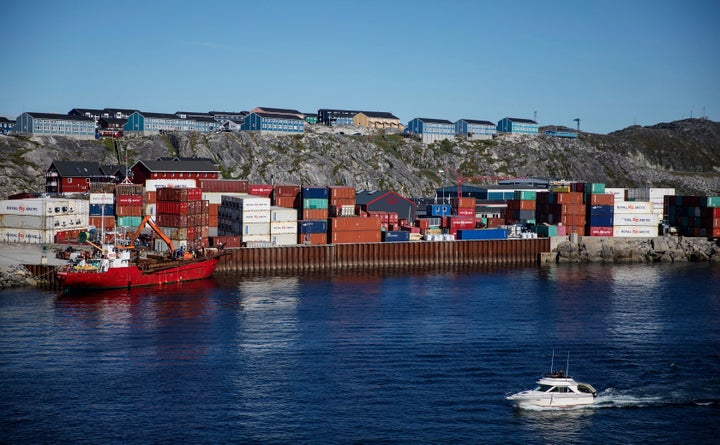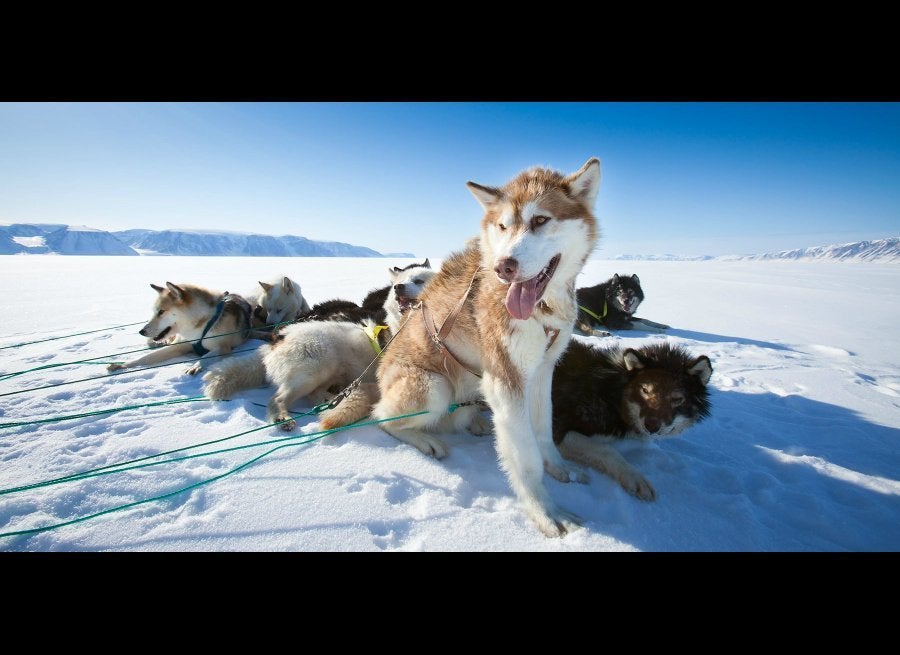Jens Borch Scharnberg was leery when a powerful empire sent a diplomat to his tiny, wind-swept fjord in one of the most remote places on Earth.
The 41-year-old is the principal of the school in Kangerlussuaq, a quiet Arctic village of about 500 in northwest Greenland. Americans are fairly common there. The U.S. military built the ice-covered island’s biggest airstrip during World War II, and maintains a significant research outfit in a town whose only major road leads to a famous and closely studied glacier.
But this diplomat’s visit was in October 2019, just two months after news broke that President Donald Trump had suggested buying and annexing Greenland. The idea became the subject of international ridicule, but rattled the autonomous Danish territory, which is ground zero for global warming and has a painful colonial history.
The delegation asked local officials what kinds of resources they needed to improve life. But far from solidarity, Borch Scharnberg saw the Americans as motivated by a desire to consolidate their government’s sphere of influence over attractive, resource-rich hinterlands.
“To me, it was sweet talk,” Borch Scharnberg, a clean-shaven and sandy-haired Dane, said over Skype last week. “It felt very deliberate.”

In hindsight, the visit looked like a scouting mission. This month, as the coronavirus pandemic raged and much of the Arctic remained in lockdown, the United States announced its biggest diplomatic expansion in Greenland in years. First, the U.S. Agency for International Development unveiled a new, $12.1 million aid package to Greenland. Days later, the State Department announced plans to open a consulate in the Greenlandic capital of Nuuk for the first time since 1953.
“It smells a bit like buying a small share of Greenland,” Borch Scharnberg said. “Suddenly Greenland became very interesting to world powers because of all the talk about who is going to get part of the North Pole and all the oil and mining there.”
The moves were the latest in a simmering conflict between the U.S. and China ― the world’s two most powerful nations and biggest climate polluters ― over control of a region whose rapidly melting polar ice is destabilizing the planet’s ecosystems but also putting previously inaccessible minerals in reach and opening new sea routes. It’s a sign, experts say, that geopolitical jockeying will pick up where it left off once officials deem travel and development work in Greenland safe to resume.

“Quite unlike Russia and the People’s Republic, America’s vision for the Arctic is based on transparency, cooperation and democratic values,” Carla Sands, the American ambassador to Denmark, wrote in an April 20 op-ed in the Danish news site Altinget. She accused Russia of “aggressive behavior and increased militarization in the Arctic” and China of promoting “predatory economic interests and authoritarian values” in Greenland.
Greenlanders, meanwhile, worry that they’re increasingly caught in the middle of a battle for their own home.
“It makes me concerned,” Bibiane Aaju Petersen, 29, a native Greenlander from Kangerlussuaq, said over Facebook Messenger. “It kinda makes it sneaky in a way, like the U.S. might end up controlling Greenland in the future.”
Battleground Of Superpowers
Trump floating the idea of buying Greenland quickly became an international joke. Some mocked the idea as absurd, another point in the constellation of data that the president’s detractors cite as evidence the former reality-TV host doesn’t know what he’s doing in the White House.
Others saw it as a half-baked plan to restore the U.S. to the halcyon days of its 19th century expansionism, when it bought Alaska from Russia, engineered a coup against Hawaii’s royal family, and sent soldiers to conquer the Philippines and Puerto Rico.
The Danish foreign ministry balked at the “completely ridiculous” idea of “selling 50,000 citizens to the United States.” But the Trumpian ham-fistedness belied the fact that U.S. interest in Greenland had been quietly growing for months.
While Greenland remained largely closed off to the outside world for much of its modern history as part of the Danish realm, the U.S. established a military presence there during World War II. Shortly after the Nazis occupied Denmark in April 1940, the U.S. ― still two years away from abandoning its official neutrality ― invaded Greenland to preserve the territory’s independence and keep the Germans from establishing a bulwark that could be used to refuel bombers headed for American cities. The U.S. offered to buy Greenland for $100 million in gold after the war. When Denmark refused, the U.S. returned control to the Danish, but held onto the Thule Air Base, transforming the northernmost American military outpost into a key node in its Cold War defense network.
Mounting tensions with Russia over the past decade gave new relevance to the site. But Greenland captured the Trump administration’s attention in 2018. As the trade conflict between the U.S. and China escalated from skirmishes to a full-blown tariff war, Beijing announced a new Arctic policy, declaring itself a “near-Arctic state” and vowing to expand its presence in the region. For China, Greenland was valuable for two big reasons. Its potential for mining rare-earth elements threatened China’s near-monopoly on the metals used for electronics and batteries. And, as new trade routes and industrial opportunities opened in the United States’ backyard, China saw a chance to open a new front in its battle with the U.S. for control of the South China Sea.
“The more you will hear about China vs. the U.S. in the South China Sea, the more you may hear about China vs. the U.S. in the Arctic,” Damien Degeorges, a regional analyst and consultant based in Reykjavík, Iceland, predicted to HuffPost in 2018.
In September of that year, the Pentagon broadcast its own plans to “pursue potential strategic investments” in Greenland “vigorously, including investments that may serve dual military and civilian purposes.”
Last May, tensions spilled over into firm rhetoric. At a meeting of Arctic Council countries in Rovaniemi, Finland, U.S. Secretary of State Mike Pompeo delivered a landmark speech titled “Looking North,” in which he warned: “There are only Arctic States and Non-Arctic States. No third category exists, and claiming otherwise entitles China to exactly nothing.”

He cautioned that China’s investments in the region followed a pattern seen in South and Southeast Asia. “Beijing attempts to develop critical infrastructure using Chinese money, Chinese companies, and Chinese workers ― in some cases, to establish a permanent Chinese security presence,” he said.
Those concerns are well founded, said Adam Lajeunesse, a scholar of Arctic geopolitics and an assistant professor at St. Francis Xavier University in Nova Scotia, Canada. When the China Communications Construction Co. bid in 2018 to build new airports in Greenland, fears swirled that the state-owned giant would import enough Chinese workers to do the job to increase Greenland’s population by a fifth.
“You don’t want to import 10,000 Chinese workers who will make slave wages,” said Lajeunesse. “What do you do? They don’t have a solution to that yet. That’s one of the things they may figure out with the assistance of the U.S.”
Another real concern, he said, is China drawing the Greenlandic government into a “debt trap” deal in which the Chinese government builds infrastructure at a cost the host country could never repay, clearing the way for Beijing to seize control of the assets.
“If the Greenlandic government were to become independent, if that government were beholden to Chinese companies for all or part of its tax revenue, resources and employment, that would give Chinese companies a lot of leverage over Greenlandic policy,” he said.
Colonial Frustrations
China has long pitched itself as a friend of Indigenous peoples seeking to free themselves from Western imperial powers. It’s a narrative that could resonate in Greenland.
Though the vast majority of the island is uninhabited, Greenland was first settled nearly 4,500 years ago when ancient migrants known to anthropologists as “paleo-Eskimos” traveled across the land bridge connecting Alaska to Siberia. Around the year 1200, another wave of migrants whose DNA is closer to that of Native Americans, arrived in Greenland. Their descendants are the Kalaallit, the Indigenous group usually identified in English as Greenland Inuits, who today make up nearly 90% of Greenland’s 56,000 inhabitants.
Nordic peoples came later, and eventually established a permanent European colony in the mid-1700s. While Greenland became part of Denmark in 1814, it wasn’t until the 1950s, after the U.S. first tried to buy the territory, that Denmark started integrating the island as a constituent of a kingdom that also included the Danish mainland and the Faroe Islands. From the 1950s and 1960s, the Danish government implemented a development scheme that forced a rapid urbanization and labor restructuring on nomadic Greenlanders. The process upended traditional ways of life and installed an administrative class of Danes whose status was preserved with laws that dictated native Greenlanders could only earn up to 85% of a civil servant’s salary.
While the population of Danes has decreased since then, the rates of suicide and alcoholism among native Greenlanders, which soared during the mid-20th century, remain persistent problems. Greenland has the highest suicide rate in the world.
“It smells a bit like buying a small share of Greenland.”
- Jens Borch Scharnberg
Greenland voted in 2009 for increased self-rule, distancing itself from Denmark. But the roughly $500 million Denmark gives to Greenland each year makes up more than half of the island’s budget and a quarter of its gross domestic product. The central theme animating Greenlandic politics is seeking independence from Denmark, a process that can only be realized by developing new industries and weaning off of Danish money.
Any “post-colonial feelings” are likely to “fade into the background very quickly when faced with real questions about economic development,” said Lajeunesse.
“Greenland will be quite happy to take money and investment from anywhere,” he said.
And U.S. dominance in the Arctic has long been a bipartisan fixation, meaning Trump’s eventual exit from the White House isn’t likely to affect long-term planning.
Industries are already moving ahead. Greenland plans to auction its first oil and gas leases in 2021. Jewelers are already selling Greenlandic rubies as the “rarest and most sought-after gemstones in the world.” Bloomberg Businessweek, meanwhile, last year dubbed Greenland’s first major rare-earths mine a “treasure island.”
But foreign aid from someone other than Denmark is another way.
“This good news confirms that our work on building a constructive relationship with the United States is fruitful,” Greenland Premier Kim Kielsen said in a statement about the U.S. aid package last week. “It is positive that the increased cooperation between Greenland and the U.S. is reflected in tangible results in the form of funding for projects in Greenland.”
Some aren’t convinced it’s that benign.
“Everyone knows this is over the desperation for minerals and oil,” Borch Scharnberg said. “It’s OK to donate money and make a better country, but this is not the way to do it. No one here is actually thinking about the Greenlanders.”

